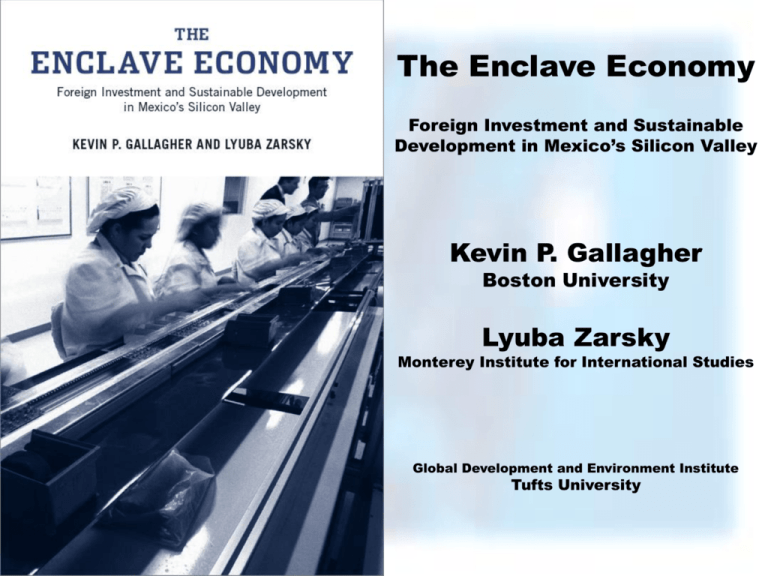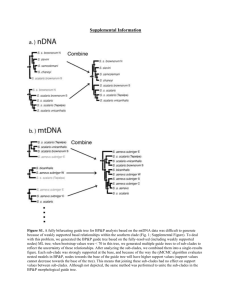Foreign Investment and Sustainable Development in Mexico
advertisement

The Enclave Economy Foreign Investment and Sustainable Development in Mexico’s Silicon Valley Kevin P. Gallagher Boston University Lyuba Zarsky Monterey Institute for International Studies Global Development and Environment Institute Tufts University Sustainable Industrial Development • Economic: – Increasing the endogenous capacities of Mexican firms and workers to learn, innovate and produce for domestic and/or global markets; • Social: – Creating jobs with labor rights, especially for the poor and middle classes; • Environmental: – Mitigating the environmental and health impacts of industrial growth. The Promise of Investment Liberalization • Attract FDI – More stable form of foreign exchange – Employment, tax revenue • Productivity spillovers – Backward linkages – Human capital spillovers – Forward linkages • Environmental Spillovers – Clean technology and management transfer – Environmental “spillovers” to domestic firms – Leapfrogging spurred by frontier environmental policy Attract FDI? Crowding Out Domestic Investment 450 400 350 FDI/GDP 1980=100 300 250 200 150 100 GFCF/GDP 50 0 1980 Source: World Bank WDI, 2007 1985 1990 1995 2000 2005 Jalisco: Electronics Exports and FDI 300 250 1995=100 200 Exports 150 100 FDI 50 0 1995 1996 1997 1998 1999 Source: Cadena Productiva de la Electronica (CADELEC), 2007 2000 2001 2002 2003 2004 2005 2006 Electronics Clusters in Mexico Source: Gallagher and Zarsky, 2007 Why firms came • • • • • • • • Proximity to U.S. Markets (hi-tech boom) NAFTA PITEX and Maquila Exchange rate Infrastructure Wages Pollution haven? Why firms left • • • • • Slowdown in U.S. demand China’s accession to WTO Overvaluation of the peso (wages) Lack of local productive capacities Lack of domestic and regional markets High Tech Project Losses in Jalisco, 2001-2003 Investment Employment Destination ($US millions) Hard Disk Drives Components Communication Systems Cell Phones Printers Printing Systems Electronic Equipment Telecommunications 108 30 n.a. n.a. 24 25 200 24 70 12 3 3 15 4,250 1,200 3,720 400 1,493 1,095 2,100 1,049 925 1,900 295 300 2,500 Total 514 21,227 Semiconductors Electronic Cards China China China China China China Phillipines China Malaysia China China China China Source: Dussel Peters, Enrique. 2005. Economic Opportunities and Challenges posed by China for Mexico and Central America: DIE (German Development Institute). Hi-Tech Employment in Jalisco, 1995-2005 90,000 80,000 70,000 60,000 50,000 40,000 30,000 20,000 10,000 0 1995 1996 1997 1998 1999 Source: Cadena Productiva de la Electronica (CADELEC), 2007 2000 2001 2002 2003 2004 2005 China vs. Mexico in World IT Markets Computers Peripherals Telecom (country exports as a percent of world exports) China 2000 Market Share 2005 Market Share Percentage Point Change 6.0 28.8 22.8 4.0 15.7 11.7 5.7 18.3 12.6 4.5 3.5 -1.0 2.2 1.2 -1.0 5.2 3.5 -1.7 Mexico 2000 Market Share 2005 Market Share Percentage Point Change Source: United Nations Commodity Trade Statistics, 2006 China: Taking Away the Ladder? 1980 1985 1990 1995 Country Share Country Share Country Share Country 1 USA 27.0% USA 25.3% USA 22.3% USA 2 Fmr Fed. Rep. of Germany 14.1% Japan 17.3% Japan 16.1% Japan 3 Japan 11.8% Fmr Fed. Rep. of Germany 11.5% Fmr Fed. Rep. of Germany 11.6% Germany 4 United Kingdom 10.5% United Kingdom 8.5% United Kingdom 7.5% Singapore 5 France 7.7% France 6.8% France 6.6% United Kingdom 6 Netherlands 4.1% Italy 3.6% Singapore 4.0% France 7 Italy 3.8% Netherlands 3.3% Netherlands 3.6% China, Hong Kong SAR 8 Switzerland 3.0% Canada 3.0% Italy 3.5% Rep. of Korea 9 Canada 2.5% China, Hong Kong SAR 2.3% China, Hong Kong SAR 2.9% Netherlands 10 Belgium-Luxembourg 2.3% Singapore 2.2% Rep. of Korea 2.8% Malaysia 11 Sweden 2.1% Switzerland 2.2% Switzerland 2.2% Italy 12 Singapore 1.7% Sweden 1.9% Canada 2.2% China 13 China, Hong Kong SAR 1.3% Rep. of Korea 1.8% Sweden 1.8% Canada 14 Rep. of Korea 1.1% Belgium-Luxembourg 1.6% Belgium-Luxembourg 1.6% Mexico 15 Poland 1.0% Ireland 1.3% Malaysia 1.6% Switzerland 16 Austria 0.9% Malaysia 1.1% Ireland 1.4% Sweden 17 Denmark 0.9% Denmark 0.8% Austria 1.1% Ireland 18 Malaysia 0.8% Austria 0.7% Spain 1.0% Thailand 19 Ireland 0.7% Spain 0.7% Denmark 0.9% Belgium-Luxembourg 20 Spain 0.6% Poland 0.5% Thailand 0.7% Spain 21 Australia 0.4% Israel 0.5% China 0.7% Finland 22 Finland 0.3% Czechoslovakia 0.4% Finland 0.5% Denmark 23 Norway 0.3% Brazil 0.4% Israel 0.4% Austria 24 Portugal 0.2% Finland 0.4% Australia 0.3% Australia 25 Hungary 0.2% Norway 0.3% Norway 0.3% Israel 26 India 0.1% Australia 0.3% Brazil 0.3% Philippines 27 Argentina 0.1% Portugal 0.2% Czechoslovakia 0.3% Norway 28So. African Customs Union 0.1% Hungary 0.2% Fmr Yugoslavia 0.2% Czech Rep. 29 Indonesia 0.1% China 0.1% Mexico 0.2% Indonesia 30 Philippines 0.1% Philippines 0.1% Poland 0.2% Brazil … … … … … … 99 China 0.0% Source: Gallagher and Porzecanski, 2007 2000 Share Country 18.1% USA 15.2% Japan 8.8% Germany 6.9% Singapore 6.8% United Kingdom 5.8% France 4.2% China, Hong Kong SAR 4.2% Rep. of Korea 3.5% China 3.3% Malaysia 2.5% Netherlands 2.1% Mexico 2.1% Canada 1.8% Ireland 1.8% Italy 1.7% Philippines 1.6% Belgium 1.5% Sweden 1.5% Thailand 0.9% Switzerland 0.8% Finland 0.7% Spain 0.6% Israel 0.4% Denmark 0.4% Hungary 0.3% Austria 0.2% Indonesia 0.2% Brazil 0.2% Australia 0.2% Czech Rep. 2005 Share Country 18.7% USA 10.8% China 7.4% Germany 5.8% Japan 5.5% China, Hong Kong SAR 5.0% Singapore 4.5% Rep. of Korea 4.4% France 4.0% United Kingdom 3.7% Netherlands 3.7% Malaysia 3.4% Belgium 2.5% Mexico 2.3% Ireland 2.0% Italy 1.8% Switzerland 1.5% Canada 1.5% Thailand 1.5% Philippines 1.4% Sweden 1.0% Spain 0.8% Hungary 0.7% Finland 0.6% Denmark 0.6% Austria 0.6% Czech Rep. 0.5% Brazil 0.5% Israel 0.3% Indonesia 0.3% Poland Share 12.6% 12.4% 9.2% 6.9% 5.9% 5.6% 4.9% 4.5% 4.5% 4.1% 3.0% 2.7% 2.6% 2.1% 1.9% 1.8% 1.6% 1.4% 1.3% 1.3% 1.1% 0.9% 0.9% 0.9% 0.7% 0.6% 0.5% 0.4% 0.4% 0.3% Generate Spillovers? Domestic Share of Inputs in Foreign Firms Sector 1990 2006 Thousands of Current Mexican pesos All Industries All inputs National Inputs National share 32,171,039 3,198,158 9.9% 719,826,926 82,038,088 11.4% Electronics All inputs National Inputs National share 4,272,927 51,339 1.2% 86,931,211 1,780,876 2.0% Source: INEGI, 2007 IT Plant Closings--Whole or Partly Owned Mexican Firms Firm Cumex Electronics Mitel Phoenix International Encitel Info Spacio Logix Computers Mexel Unisys Electron Scale Computers Advanced Electronics Compuworld Microtron Ownership (percent) Activity 50/50 Mex-US 51/49 Mex-Canada 50/50 Mex-US 100 Mex 100 Mex 100 Mex 100 Mex 100 Mex 100 Mex 100 Mex 100 Mex 100 Mex 100 Mex CM of PCBs Telephone Components Plastic Injection CM of PCBs CM of printers Design and manufacturer of PCs CM of PCBs CM of computers and peripherals Design and manufacturer of PCs Design and manufacturer of PCs Design and Manufacturer of PCBs CM of hard drives Buffers and Carton Packages Source: Gallagher and Zarsky 2007 Backward Linkages • 98 percent of inputs are imported • 80 percent decline in local suppliers from 1985 • 97 percent of all investment between 1994 and 2002 was foreign • Survival story: – Electronica Pantera Human Capital Spillovers • Assembly work: – Contract employees – “basic” training – Limited joint R&D • Few domestic firms to spill over to • Success story: – IBM training center and spin-offs Forward Linkages • Hi-tech diffusion relatively low • Limited success of “digital divide” projects National Demand as a Percent of Total Production IT Firms in Mexico 60% 50% 40% 30% 20% 10% 0% 1985 Source: INEGI, 2007, Peres, 1992 1995 1998 2001 Why so few spillovers? • Market Failures – Barriers to entry into global supplier networks – No access to credit and finance – Environmental externalities • Government Failures – – – – Orientation of ISI Incentive to import inputs Macroeconomic uncertainty Little R&D, human capital formation, leveraging • Firm failures – Little R&D – Weak capacity – Scale NAFIN Credit to SMEs in Jalisco 450 400 350 1991=100 300 Million Pesos 250 200 150 100 # of recipients 50 0 1991 1992 1993 1994 Source: Gobierno del Estado de Jalisco, 2001 1995 1996 1997 1998 1999 2000 China: Major Consumer Electronics Firms by Ownership Type Sector Foreign-Owned Joint-Ventures Domestic Firms and SOEs Mobile Phones Motorola Motorola/Eastcom Nokia/Capitel, Southern Siemens/Mil Subsidiaries Samsung/Kejian Sagem/Bird TLC PCs HP Dell IBM/Great Wall Toshiba/Toshiba Shanghai Epson/Start Taiwan GVC/TCL Lenovo Founder Tongfang Sony/SVA Philips/Suzhou CTV Toshiba/Dalian Daxian Great Wall Electronics/TCL Changhong Konka Hisense Skyworth Haier Panda Xoceco Samsung/Suzhou Xianxuehai Electrolux/Changsha LG/Chunlan Mitsubishi/Haier Sanyo/Kelon Sigma/Meiling Hong Leong/Xinfei Toshiba Carrier/Midea Changling Gree "Brown Goods" "White Goods" Siemens Source: Rodrik, Dani (2005), "Policies for Economic Diversification," CEPAL REVIEW, 87, December, 7-23 . Environmental Spillovers? IT Assembly and Environment • Copper and soldering of plates with lead and tin – Formaldehyde and solder drass • Exposure and waste water issues • Adding brominated flame retardants to circuit boards to reduce flammability – Polybrominated diphenyl ether PBDE • Bioaccumulative • E-waste Environmental Spillovers • Technology Transfer: – Vintage effects vs. end-of-pipe – Bringing EMS but not clear if in compliance – SCI-Sanmina and Industria Limpia program • Greening the supply chain: – Little contact with local suppliers to begin with – HP: workshops with locals, some ISO requirements • Exporting to higher standards: – Not in Guadalajara plants (but in plants closer to higher regulation markets) – Globalization of environmentalism Lessons for Mexico and Beyond • FDI is a means to development, not an end in itself • Complementary domestic policies are needed to facilitate spillovers, growth and environmental protection • Trade and financial agreements must preserve the ‘policy space’ for complementary efforts on a national scale Stanford University Press www.sup.org Available from MIT Press www.mitpress.mit.org Earthscan Publications www.earthscan.co.uk Available from MIT Press www.mitpress.mit.org What to do? • Strategies: – Build domestic capacities for production and innovation (education, R&D, infrastructure) – Reduce domestic cost of capital – Build domestic and regional markets – Establish ROHS-like environmental regulations for Mexico • Challenges: – Fiscal crisis – Government capacity – Constraints of trade regimes – Inflation – Relative wage/productivity/policy space of China Electronics Clusters in Mexico Mexicali Tijuana SANYO SONY HITACHI MATSUSHITA JVC SAMSUNG PIONNER MITSUBISHI SHARP SANYO ELECTRODOMÉSTICOS PHILIPS CASIO KODAK CANON KYOCERA INTERNACIONAL RECTIFIER Guadalajara I.B.M H.P. TECHNICOLOR TELECT TYCO KODAK VOGT ELECTRONIC SIEMENS VDO SONY DAEWOO (SLRC) MITSUBISHI GOLDSTAR Chihuahua MOTOROLA ALTEL KIOCERA JABIL Juárez TOSHIBA PHILIPS THOMSON KENWOOD ELECTROLUX ACER ELAMEX PLEXUS Reynosa DELCO (Automotriz) PHILIPS SONY MATSUSHITA (Automotriz) VITROMATIC NOKIA LUCENT TECHNOLOGIES FUJITSU (Automotriz) CONDURA (Automotriz) DELNOSA (Automotriz) State of Mexico PANASONIC ELECTROLUX FILTER QUEEN HOOVER IMAN KOBLENZ MABE PHILIPS SUNBEAM OLIVETTI OLIMPIA SOLECTRON DE MEXICO FLEXTRONICS JABIL CIRCUIT BENCHMARK SANMINA-SCI AUDIO & VIDEO ELECTRODOMESTIC COMPUTER EQUIPMENT TELECOM OTHER


